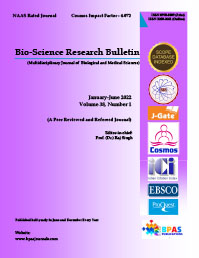A Study on Hydroponic Farming System of Wheat, Spinach and Sword Lily for Sustainable Development of Agriculture
DOI:
https://doi.org/10.48165/Keywords:
Hydroponics, Triticum sp, Spinacea sp, Gladiolus sp, Cereals, Vegetables, Flowering crops, Hoagland solutionAbstract
The continuous augmented demand of food production is escalating with increase of world population. The traditional farming system will not be able to cover the world's emergent demand for food with rising pollution level and oscillations in climate. The design and development of new farming and planting system technique is urgent requirement to stay away from food catastrophe in future. The present study aimed to examine an efficient lab to land transfer technique for alternative agri-farming system, the hydroponic system. The in vitro data was evaluated and validated through numerical tools for comparative accounts between hydroponics and tap water system against Triticum sp. (Poales: Poaceae), Spinacea sp. (Caryophyllales: Amaranthaceae) and Gladiolus sp. (Asparagales: Iridaceae). The results showed that wheat, spinach and sword lily showed very good growth in Hoagland solution in comparison to tap water. Thus the field application of the proposed hydroponic system for cereals, vegetables and flowering crops will meet the world wide demand of today and future by sustainable agriculture farming approaches.
References
Beibel, J.P. (1960). Hydroponics- The science of growing crops without soil. Florida Dept. Agri. Bull. 180p.
Besthorn, F.H. (2013). Vertical farming: Social work and sustainable urban agriculture in an age of global food cries. Australia Socl. Work 66(2): 187–203.
Bhattarai, P.S., Clemence, S. and Midmore, J. (2008). Oxygenation of the rock wool substrate for Hydroponics. Aquaponics J. 49: 29–33.
Chow, Y.N., Lee L.K, Zakaria, N.A. and Foo, K.Y. (2017). New emerging hydroponicsystem. School Indust. Technol., Univ. Malaysia 2: 353–358.
Douglas, W. (1975). Hydroponics: The Bengal System (5thed.). New Delhi: Oxford University Press.
Ferguson, S.D., Saliga, R. and Omaya, S.T. (2014). Investigating the effects of hydroponic media on quality of greenhouse grown leafy greens. Dept. Agri. Nutri. Vet. Sci. Univ. Reno, USA 02(03): 227–234.
Gashgari, R., Alharbi, K. and Gholam, A. (2018). Comparison between growing plants in hydroponic system and soil based system. Dept. Indust. Engi. King Abdulaziz Univ., Saudi Arabia, I.C.M.I.E. 131: 1–7.
Gericke, W.F. (1940). The complete guide to soilless gardening. The nutrient film technique (eds N.J. Graves, C.G. Cliffs) Prentice-Hall, Englewood. Hort. Rev. 5: l–44.
Ghamonde, M.V., Medhekar, R., Mathew, A., Kalake, N., Patil, B. and Bhandia, D. (2016). Growing plants using nutrients media (Hydroponics). Dept. Engi. Sci. Humanities, VIT, SP Pune, Univ., India 3: 164–165.
Hamilton, A.J., Frank, S., Xianzhe, X., Simone, L.K., Kurt, K.B. and Maher, P. (2007). Wastewater Irrigation –The state of play. Vadose Zone J. 6(4): 823–840.
Hoagland, D.R. and Arnon, D.I. (1938). The water culture method for growing plants without soil. California Agri. Expt. Sta. Circ. 347p.
Jensen, M.H. and W.L. Collins.(1985). “Hydroponic vegetable production”.Hort. Rev. Volume 7:483–558.
Jimenez, B. and Asano, T. (2008). Water reuse: An international survey of current practice issues and needs. London I.W.., 650p.
Kazzaz, K.A. and Kazzaz, A.A. (2017). Soil–less agriculture a new and advanced method for agriculture development: An introduction. Dept. Plant Biotechnol. Natl. Res. Centre, Giza, Egypt Doi: 10.19080.
Keraita, B., Jimenez, B. and Dreschel, P. (2008). Extent and implications of agricultural reuse of untreated, partly treated and diluted wastewater in developing countries. CAB Reviews: Persp. Agri. Vet. Sci. Nutri. Natual Resources, 3(58): 15–17.
Kumari, S., Pradhan, P., Yadav, R. and Kumar, S. (2018). Hydroponic techniques: A soil less cultivation in agriculture. J. Pharmacog. Phytochem. 7: 1886–1891.
Lommen, W.J. (2017). The canon of potato science-Hydroponics. Potato Res. 50(3): 315–318. 18. Molitor, H. (1989). The european perspective with emphasis on sub-irrigation and recirculation of water and nutrients. In: Symposium on bedding and pot culture. 272: 165–174. 19. Montgomery, D.C. (2018). Design and analysis of experiment (8th ed.). John Wiley & Sons, Inc. 20. Pandey, R., Jain, V. and Singh K.P. (2009). Hydroponic agriculture: Its status, scope and limitations. Ind. Agri. Res. Inst. New Delhi pp20-29.
Podmirseg (2014). Contribution of vertical farms to increase the overall energy efficiency of urban agglomerations. J. Power Energy Engi. 2(4): 82–85.
Samangooei, M., Sassi, P. and Iack, A. (2016). Soil-less systems vs. soil-based systems for cultivating edible plants on buildings in relation to the contribution towards sustainable cities: Future of Food. J. Food Agri. Soc. 4(2): 24–39.
Sardare, M. and Admane, S. (2013). A review on soil-less culture. MIT Acad. Engi. Alandi Pune, MS, India 2: 299–304.
Somerville, C., Cohen, M., Pantanella, E., Stankus, A. and Lovatelli, A. (2018). Small-scale aquaponic food production. Food and Agriculture Organizations of the United States Rome 589: 83–98.
